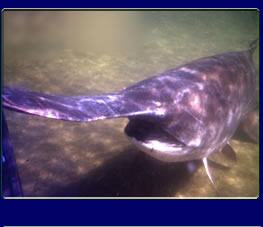- Home
- About S&T
- Taxa/Organisms
- Ecosystems
- Issues
- Methods & Tools
- Reports & Publications
- Location
- Search
Publisher: USGS | Science Center: Leetown Science Center (LSC, Kearneysville) | Format: URL
www.lsc.usgs.gov — This is a research project whose primary objective is to assess the health of selected fish species (brown bullhead and largemouth bass) and compare these findings with historic information on fish health in the individual rivers and with concurrent samples collected at reference sites. A secondary objective is to compare and correlate the fish More...

2008 | Publisher: Other (RSC Publishing, Journal of Environmental Monitoring) | Format: URL
www.rsc.org — Environmental contaminant and biomarker monitoring data from major U.S. river basins were summarized for black bass (Micropterus spp.) and common carp (Cyprinus carpio) sampled over a nine year period. Cumulative frequency distributions revealed taxon differences for many organochlorine residue concentrations, elemental contaminant concentrations, More...

2008 | Publisher: USGS | Format: URL
pubs.usgs.gov — This study determined that concentrations of persistent hydrophobic contaminants, such as polycyclic aromatic hydrocarbons (< picograms per liter), legacy pesticides (<10 picograms per liter), and polychlorinated biphenyls (<280 picograms per liter) were low and indicative of a largely agricultural area. Atrazine and simazine were the most More...

May 4 2007 | Publisher: Other (Springer New York) | Format: URL
www.springerlink.com — This project is an evaluation of three potentially nonlethal alternatives to fillet sampling for the determination of mercury (Hg) concentrations in smallmouth bass (Micropterus dolomieu) to monitor mercury concentrations in smallmouth bass (micropterus dolomieu) from six sites in southern Missouri were captured by electrofishing. Blood samples More...

September 2006 | Publisher: USGS | Format: URL
pubs.usgs.gov — This report documents the spatial trends in the concentrations of accumulative contaminants and assesses the contaminant effects on the fish from the Colorado River Basin.

2002 | Publisher: USGS | Science Center: Western Fisheries Research Center (WFRC, Seattle) | Format: URL
wfrc.usgs.gov — The value of this long-term monitoring program will provide data crucial for understanding demographic and reproductive characteristics of these endangered sucker populations. This research will have wide applicability to federal, state, and tribal agencies in the basin for management and recovery efforts.

2002 | Publisher: USGS | Science Center: Great Lakes Science Center (GLSC, Ann Arbor) | Format: .PDF
www.glsc.usgs.gov — In 2002, scientists from the Great Lakes Science Center assessed the health of the populations of preyfish for the biennial State of the Lakes Ecosystem Conference (SOLEC) to provide information to policy makers on the status of the lakes and future needs. Preyfish population is one of the 80 indicators used by SOLEC to determine the health of the More...

September 10 2000 | Publisher: Other (Grand Canyon Monitoring and Research Center) | Format: .PDF
www.gcmrc.gov — Lees Ferry was stocked with Rainbow Trout in the early 1960`s. Since then, it has been a nationally acclaimed and world renowned blue ribbon fishery. With its value as a recreational play land for fishermen and safe haven for wildlife, the function and impact of the Glen Canyon Dam has become increasingly important for study and monitoring.

Publisher: USGS | Science Center: Forest and Rangeland Ecosystem Science Center (FRESC, Corvallis) | Format: URL
fresc.usgs.gov — This dataset is an ArcInfo point coverage depicting obstacles to anadromous fish migration in western Oregon. Data were compiled by fourth-field hydrologic unit code (HUC) from the Oregon Department of Fish and Wildlife StreamNet Database and from reports by fisheries biologists in various management agencies. Both natural and constructed (e.g., More...

Publisher: USGS | Science Center: Western Fisheries Research Center (WFRC, Seattle) | Format: URL
wfrc.usgs.gov — This project addresses the occurrence of metal and organochlorine contaminant residues in commercial feeds purchased by the U.S. Fish and Wildlife Service (FWS) hatcheries. Research into fish feed quality could benefit all hatchery and aquaculture operations and assist in the interpretation of the effects of pollution on wild fish. Results from More...

Publisher: USGS | Science Center: Upper Midwest Environmental Sciences Center (UMESC, LaCrosse) | Format: URL
www.umesc.usgs.gov — Paddlefish (Polyodon spathula) have been lost from four states and Canada, and 11 of 22 states within the remaining species range now list the paddlefish as endangered, threatened, or a species of special concern. Restoration of paddlefish populations is a shared goal of many state and federal agencies. UMESC scientists, in collaboration with the More...

Publisher: USGS | Science Center: Columbia Environmental Research Center (CERC, Columbia) | Format: .PDF
www.cerc.usgs.gov — The study described in this report was conducted as part of the USGS Biomonitoring of Environmental Status and Trends (BEST) Program. This project collected, examined, and analyzed 217 fish representing three species at 10 stations in the US portion of the Yukon River Basin (YRB) from May to October 2002. Four sampling sites were located on the More...
